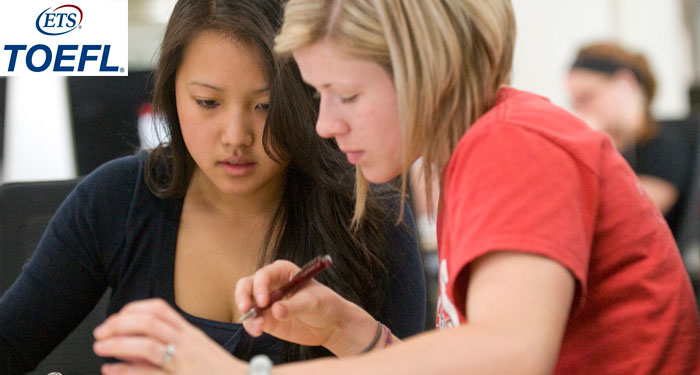TOEFL Listening Question Types for iBT and PBT- TOEFL or Test of English as a Foreign Language has 4 sections, which includes a Listening Section (for TOEFL iBT) and Listening Comprehension section (for TOEFL PBT). The Listening section (for iBT) measures your ability to understand conversations and lectures in English. The Listening Comprehension section of PBT measures the ability to understand spoken English.
TOEFL Listening Question Types:
(For details on the time allocated and number of lectures/conversations of Listening sections in each paper, refer to Introduction to the TOEFL Listening Test)
TOEFL iBT
What will the questions require you to do and how to prepare for them?
1. Listening for Basic Comprehension
Major task: Comprehend the main idea, major points and important details related to the main idea
How to prepare: Listen to different kinds of material on a variety of topics, of increasing length and difficulty.
- Start with recordings on familiar topics and gradually progress to topics that are new to you.
- First, listen to conversations, Television Shows and movies, and then listen to programs with academic content, such as NPR and BBC broadcasts. Start with short segments and progress to longer segments.
- Listen several times to each recording:
- For beginners, listen first with English subtitles, if they are available. Then, without subtitles, listen for the main ideas and key details. Listen again to understand the connections between ideas, the structure of the talk and/or the speakers’ attitudes and to distinguish fact from opinion.
- Listen actively: Take notes as you listen for main ideas and important details. Write down key words only, not every word. Keep a log of the new words and expressions you hear. Check the spelling and meaning in a dictionary. Ask yourself about the basic information presented in the recording (Who? What? When? Where? Why? How?). Make predictions about what you will hear next. Use your notes to summarize what you’ve heard.
- Copy a script from an online news story, lecture or talk, movie or podcast. Delete or cover every fifth word on the script. Listen to the recording, and try to write in the missing words.
Sample question:
What is the lecture mainly about?
(A) The importance of creating believable characters in plays
(B) The influence of the literature of “realism” on French theater
(C) A successful standard formula for writing plays
(D) A famous example of a well-made play
2. Listening for Pragmatic Understanding
Major task(s): Recognize a speaker’s attitude and degree of certainty. Recognize a speaker’s function or purpose.
How to prepare: As you listen to movies, television shows and lectures:
- Think about what each speaker hopes to accomplish. What is the purpose of the lecture or conversation? For example, is the speaker apologizing, complaining, inviting or making suggestions?
- Notice each speaker’s style. Is the language formal or casual? How certain does each speaker sound? Is the speaker’s voice calm or emotional? What does the speaker’s tone of voice tell you?
- Notice the speaker’s degree of certainty. How sure is the speaker about the information? Does the speaker’s tone of voice indicate something about his/her degree of certainty?
- Pay attention to the way stress and intonation patterns are used to convey meaning. Replay segments multiple times, listening for shades of meaning. This will help you understand a speaker’s point of view.
- Listen for changes in topic. What transitions are used? – Listen for repetitions of ideas and paraphrases. How do speakers reinforce their points?
Sample Questions:
Why does the professor mention a conversation between two servants?
(A) To give examples of typical characters in a well-made play
(B) To show how background information might be revealed in a well-made play
(C) To explain why Romeo and Juliet can be considered a well-made play
(D) To explain how playwrights develop the obligatory scene of a well-made play
3. Connecting and Synthesizing Information
Major task(s): Recognize the organization of information presented. Understand the relationships between ideas presented (for example: compare/contrast, cause/effect or steps in a process). Make inferences and draw conclusions based on what is implied in the material. Make connections among pieces of information in a conversation or lecture. Recognize topic changes in lectures and conversations, and recognize introductions and conclusions in lectures.
How to prepare: As you are listening to recorded lectures or talks:
- Think about how what you’re hearing is organized. Listen for the signal words that indicate the introduction, major steps or ideas, examples and the conclusion or summary.
- Identify the relationships between ideas. Possible relationships include cause/effect, compare/contrast and steps in a process.
- Listen for transitions that show connections and relationships between ideas. How do speakers introduce and organize their points?
- Predict what information or idea will be expressed next.
- Stop the recording at various points. Summarize what you just heard or what you’ve heard up to that point.
- Practice listening for and comparing two speakers’ viewpoints. Which speaker supports the idea and which is against it? What words do speakers use to support their ideas? Are the words mainly positive or negative?
Sample Question(s):
A. What does the professor imply about the obligatory scene and the denouement?
(A) The difference between them might be unclear to some people.
(B) Both are useful techniques for developing realistic characters.
(C) The denouement usually occurs within the obligatory scene.
(D) The obligatory scene is usually less exciting than the denouement.
B. Part of the lecture is repeated below. Read it and answer the question.
Professor: This is the inciting incident. It sets off the plot of the play.
Why does the professor say this: “It sets off the plot of the play.“
(A) To help students understand the meaning of a new term
(B) To indicate that his point is not related to the main topic of the lecture
(C) To emphasize one element of a play over all others
(D) To begin to summarize the main points of the lecture
(These are not independent questions. They follow a lecture in the Listening section of the iBT, given here to present a general layout.)
TOEFL PBT
As elaborated in Introduction to the TOEFL Listening Test, there are three parts of the TOEFL PBT Listening Comprehension section. The ‘Major Tasks’ and ‘Preparation Techniques’ remain approximately the same as TOEFL iBT (given above this section). The sample questions for each Part are given below:
1. Part A: This section includes short conversations between people, followed by a question. The conversations and questions will not be repeated.
Sample Question:
On the recording, you will hear:
| (woman) | I don’t like this painting very much. |
| (man) | Neither do I. |
| (narrator) | What does the man mean? |
In your test book, you will read:
| A. He doesn’t like the painting either.B. He doesn’t know how to paint.C. He doesn’t have any paintings.D. He doesn’t know what to do. |
2. Part B: It consists of longer conversations between two or more people, followed by several questions. The conversations and questions will not be repeated.
Sample Question:
| (narrator) | Questions 4 through 7. Listen to a conversation about a trip. (TRANSCRIPT OF WHAT WILL BE HEARD) |
| (man) | Are you ready for “The Big Apple”? |
| (woman) | Excuse me? |
| (man) | You know, New York City. You are going to New York with us, aren’t you? I wanted to show everybody around my old neighborhood. |
| (woman) | Oh…sure! I wouldn’t miss it especially when the tour guide is a native New Yorker. |
| (man) | I thought we could start at the Museum of Modern Art. Right now there’s an exhibit on twentieth-century American painters. |
| (woman) | Fine with me…but what were you saying about…a big apple? |
| (man) | “The Big Apple.” It’s a nickname for New York. I think I heard once that it started with jazz musicians in the 20’s. |
| (woman) | Oh. |
| (man) | Whenever they played a concert in a city, they called that city an “apple.” In those days, New York was the biggest city in the country, so they called it “The Big Apple.” |
| (woman) | Hey, I have an idea! Let’s go to a jazz club while we’re there. |
| (man) | Sounds good. |
| (narrator) | What is the man planning to see? |
| A. An art exhibit. | |
| B. A Broadway play. | |
| C. A modern dance production. | |
| D. An opera. |
| (narrator) | What can be inferred about the man? |
| A. He is a jazz musician. | |
| B. He wants to join the woman’s club. | |
| C. He is in his twenties. | |
| D. He was born in New York. |
3. Part C: This part will consist of a lecture/talk delivery, followed by several questions. Both will not be repeated.
Sample Question:
| (narrator) | Listen to an instructor talk to his class about a television program. (TRANSCRIPT OF WHAT WILL BE HEARD) |
| (man) | I’d like to tell you about an interesting TV program that’ll be shown this coming Thursday. It’ll be on from 9 to 10 p.m. on Channel 4. It’s part of a series called “Mysteries of Human Biology.” The subject of the program is the human brain — how it functions and how it can malfunction. Topics that will be covered are dreams, memory, and depression. These topics are illustrated with outstanding computer animation that makes the explanations easy to follow. Make an effort to see this show. Since we’ve been studying the nervous system in class, I know you’ll find it very helpful. |
(narrator) Why does the speaker recommend watching the program?
| A. It is required of all science majors. | |
| B. It will never be shown again. | |
| C. It can help viewers improve their memory skills. | |
| D. It will help with course work. |
NOTE: Making notes is allowed in the iBT paper, but NOT allowed in the PBT paper. Students must prepare accordingly.
(Source: ETS website)





















































